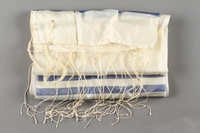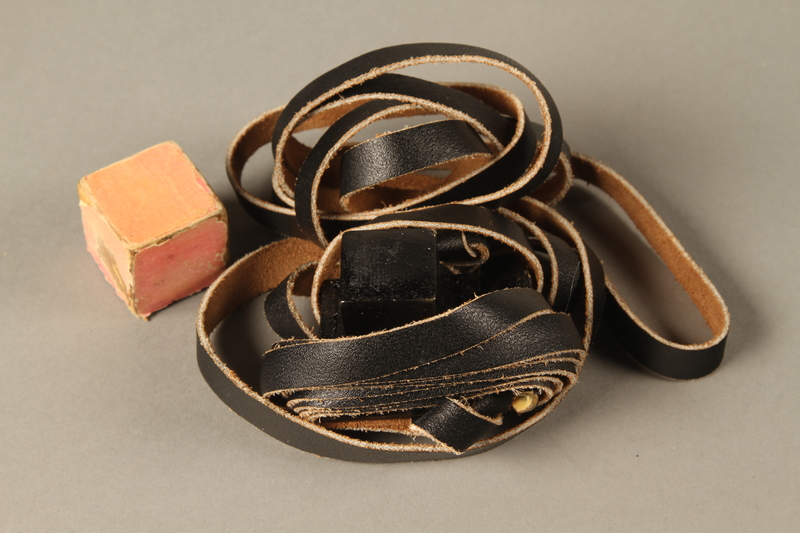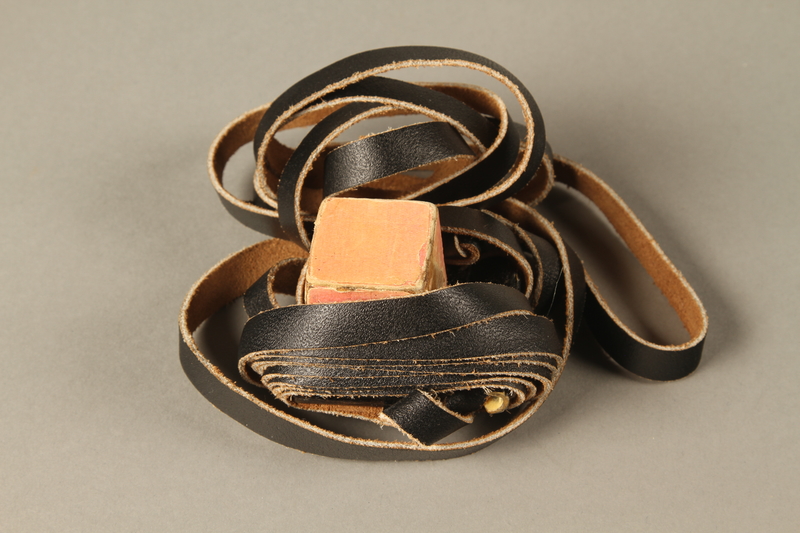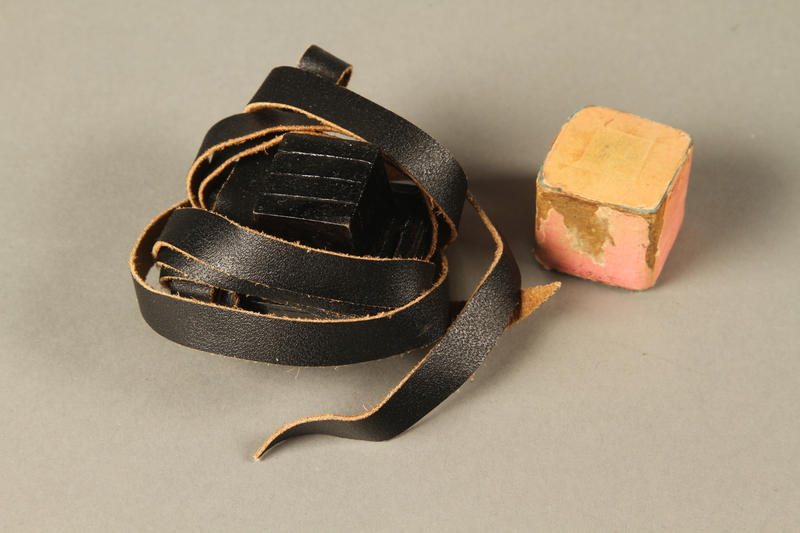Overview
- Brief Narrative
- Pair of tefillin and an embroidered velvet pouch given to Bernat Berkowitz (later, Berk) by a U.S. Army chaplain while he was in a displaced persons facility in Germany between May 1946 and December 1947. Tefillin are small boxes containing prayers attached to leather straps and worn by Orthodox Jewish males during morning prayers. Bernat lived with his parents and three younger brothers in Chust, Czechoslovakia, when the region was annexed by Hungary with the aid of Germany in 1939. On April 20, 1944, the entire family (except Bernat’s brother, Herman, who was an apprentice in Budapest) were forced into a ghetto in Chust, and then deported to Auschwitz concentration camp in German-occupied Poland. Bernat’s parents, Regina and Israel, and youngest brother, Isik, were killed soon after their arrival, while Bernat and his brother, Samuel, were separated and both sent to numerous camps. Bernat was sent to Fünfteichen and Mauthausen, where he was liberated by American forces on May 5, 1945. After the war, Bernat reunited with Samuel and Herman in Czechoslovakia. In August, Samuel immigrated to London and then to the United States, while Bernat and Herman lived in the Pocking displaced persons (DP) camp in the American zone of Germany. While there, both brothers contracted tuberculosis and were treated in multiple facilities until they were transferred to the Etania Jewish Sanatorium in Davos, Switzerland, in December 1947. While in Davos, Bernat met Adela (Ada) Kochanski, a fellow Holocaust survivor, who was also receiving treatment for tuberculosis. In the fall of 1948, Bernat married Ada. In 1949, Herman immigrated to Australia, and in 1950, Bernat and Ada followed him there before moving to the United States around 1954.
- Date
-
received:
after 1946 May-before 1947 December
- Geography
-
received:
Germany
- Credit Line
- United States Holocaust Memorial Museum Collection, Gift of Steve, Linda, and Amanda Berk
- Markings
- a. left and right sides, embossed : ש
e. pouch front, embroidered, yellow thread: [Hebrew characters] [tefillin]
e. zipper pull, front and back, embossed, metal: M / O / N / T - Contributor
-
Subject:
Bernat Berk
- Biography
-
Bernat Berk (born Bernat Berkowitz, 1926-2017) was born in Chust, Czechoslovakia (Khust, modern-day Ukraine), to Israel (1898-1944) and Regina (1900-1944) Berkowitz. Israel owned a brick factory in Chust while Regina was a housewife. Bernat had three brothers, Herman (1928-1985), Samuel (1929-2015), and Isik (c. 1932-1944), and attended a public primary school for eight years. In 1938 and 1939, Germany, Hungary, and Poland annexed territory from Czechoslovakia. Hungary occupied Chust (Huszt in Hungarian) in 1939, increasing anti-Jewish sentiment, violence, and persecution. In 1943, Herman moved to Budapest, Hungary, to begin an iron-working apprenticeship, and the following year was sent to a labor camp in Budapest, where he remained until liberation in 1945.
On March 19, 1944, Germany occupied Hungary, their former ally, when the country attempted to negotiate an armistice with the western Allies. In April, German authorities established three separate ghettos in Huszt, under the management of a five-member Jewish Council and a Jewish police force. On April 20, the Berkowitz family was among the 11,000 Jews forced into a ghetto and soon thereafter was among the 440,000 Hungarian Jews deported to Auschwitz concentration camp in German occupied Poland. Israel, Regina, and Isik were killed at Auschwitz soon after arrival while Bernat and Samuel were separated and each deported to numerous camps. Samuel was sent to Buchenwald, Bochum, and Dachau concentration camps in Germany, where he was liberated by American forces on May 5, 1945.
Bernat was first deported to Fünfteichen, the largest sub-camp of the Gross-Rosen system in Poland. This sub-camp partnered with an armaments factory that manufactured 75mm and 150mm cannons and torpedo launchers. Most of the prisoners were forced to work in the factory and endured 12-hour shifts and a three-kilometer round trip walk to the plant. On January 21, 1945, the SS began evacuated the prisoners in Fünfteichen, and sent them on a four-day forced march in subzero temperatures back to Gross-Rosen. Approximately 1,000 of the 6,000 prisoners died during the march.
On February 15, 1945, Bernat was deported to Mauthausen concentration camp in Austria, where he was liberated by American forces on May 5. After liberation, Bernat moved to Chemotow, Czechoslovakia, where he worked as an auto mechanic and was able to earn enough money to reunite with his younger brothers . Samuel immigrated to England in August 1945. In May 1946, Bernat and Herman immigrated to the American zone in Germany, settling in Pocking displaced persons (DP) camp. While there, both brothers contracted tuberculosis, and were transferred from the Pocking hospital to the DP hospital in Zaitzkofen, Germany. The brothers’ American uncle Martin, who lived in New York, arranged and paid for their transfer to the Etania Jewish Sanatorium in Davos, Switzerland, where they arrived on December 5, 1947. Samuel emigrated from England to Chicago in April 1948. After recovering from TB, Herman left Switzerland in October 1948, and immigrated to Australia in 1949. He immigrated to California in the 1950s.
While in Davos, Bernat met Adela (Ada) Kochanski (1927-?), who was also receiving treatment for tuberculosis. Ada was born in Łódź, Poland, was forced into the Łódź Ghetto. After four years, she was deported to multiple concentration camps, including Auschwitz, Bergen-Belsen, Rochlitz, and Kraslitz. The two married in the fall of 1948, and moved to Basel in 1949. On July 24, 1950, the couple left Switzerland for Brisbane, Australia with assistance from the American Joint Distribution Committee (AJDC) and the Australian Jewish Welfare Society, and changed their last name to Berk. Around 1954, the couple immigrated to Washington, D.C., where Ada’s parents lived. In 1959, Bernat became a naturalized U.S. citizen. Bernat and Ada had two children and relocated to be close to his brother Samuel near Chicago. After Ada died, Bernat moved to Arizona, where he remarried and belonged to the Phoenix Holocaust Survivors’ Association until his death.
Physical Details
- Language
- Hebrew
- Classification
-
Jewish Art and Symbolism
- Category
-
Jewish ceremonial objects
- Object Type
-
Tefillin (lcsh)
- Genre/Form
- Ceremonial objects.
- Physical Description
- a. Head tefillin with a square, black painted, leather box (batim) constructed of 4 leather panels with an embossed Hebrew letter Shin on the left and right sides; the right Shin has four strokes. The box is centered on a black painted, square, multi-layered leather platform sewn together with gut from kosher animals (giddin). A black leather strap (retzu’ot) is wrapped around the tefillin, obscuring the platform. The underside of the strap is unfinished and is likely threaded through a triangular notch on the back of the platform. The box interior is likely divided into 4 sections and hold 4 parchment scrolls (parshiyot) inscribed with Hebrew prayers.
b. Small, hollow, cube-shaped, removable cardboard cover for a tefillin. The exterior has pink paper squares adhered to the sides. The interior is lined with a pink, fuzzy, coarse weave fabric, now stained and fraying. The pink paper has remnants of black ink printed onto the surface and the paper is torn in multiple places. The cover is for head tefillin (a).
c. Hand tefillin with a square, black painted, leather box (batim) with smooth sides. The box is centered on a black painted, square, multi-layered leather platform, which is sewn together with gut from kosher animals (giddin). A black leather strap (retzu’ot) is wrapped around the tefillin, obscuring the platform. The underside of the strap is unfinished and is likely threaded through a triangular notch on the back of the platform. The box likely holds a parchment scroll (parshiyot) inscribed with 4 Hebrew prayers.
d. Small, hollow, cube-shaped, removable cardboard cover for a tefillin. The exterior has pink paper squares adhered to the sides. The interior is lined with a pink, fuzzy, coarse weave fabric, now stained and fraying. The pink paper has remnants of black ink printed onto the surface and the paper is torn in multiple places. The cover is for hand tefillin (c).
e. Rectangular, navy blue velvet pouch with a brass colored metal zipper closure at the top. The front design is satin stitched in yellow thread with Hebrew text above an open book. The reverse has a rectangular impression in the velvet, matching a prayer book (2018.297.2a). The interior of the pouch is lined with a shiny, off-white fabric. - Dimensions
- a: Height: 2.250 inches (5.715 cm) | Width: 3.500 inches (8.89 cm) | Depth: 2.750 inches (6.985 cm)
b: Height: 1.000 inches (2.54 cm) | Width: 1.250 inches (3.175 cm) | Depth: 1.250 inches (3.175 cm)
c: Height: 3.250 inches (8.255 cm) | Width: 4.250 inches (10.795 cm) | Depth: 2.750 inches (6.985 cm)
d: Height: 1.000 inches (2.54 cm) | Width: 1.125 inches (2.858 cm) | Depth: 1.125 inches (2.858 cm)
e: Height: 5.500 inches (13.97 cm) | Width: 7.000 inches (17.78 cm) | Depth: 1.000 inches (2.54 cm) - Materials
- a : leather, paint, gut, paper, ink
b : cardboard, paper, ink, cloth
c : leather, paint, gut, paper, ink
d : cardboard, paper, ink, cloth
e : velvet, cloth, metal, thread
Rights & Restrictions
- Conditions on Access
- No restrictions on access
- Conditions on Use
- No restrictions on use
Keywords & Subjects
Administrative Notes
- Legal Status
- Permanent Collection
- Provenance
- The tefillin and bag were donated to the United States Holocaust Memorial Museum in 2018 by Steve, Linda, and Amanda Berk, the son, daughter-in-law, and granddaughter of Bernat Berk.
- Record last modified:
- 2023-08-24 14:00:30
- This page:
- https://collections.ushmm.org/search/catalog/irn620109
Also in Bernat Berk collection
The collection consists of a prayer book with loose inserts, a pair of tefillin with covers and pouch, a Tallis with a bag, documents, and photographs relating to the experiences of Bernat Berk as a displaced person in Germany, Switzerland, and Australia after the Holocaust.
Date: 1945-1993

Tallis with bag given to a Czechoslovakian Jewish man by a U.S. Army chaplain
Object
Tallis and fabric pouch given to Bernat Berkowitz (later, Berk) by a U.S. Army chaplain while he was in a displaced persons facility in Germany between May 1946 and December 1947. A tallis is a specialized shawl worn by Orthodox Jewish males during morning prayers. Bernat lived with his parents and three younger brothers in Chust, Czechoslovakia, when the region was annexed by Hungary with the aid of Germany in 1939. On April 20, 1944, the entire family (except Bernat’s brother, Herman, who was an apprentice in Budapest) were forced into a ghetto in Chust, and then deported to Auschwitz concentration camp in German-occupied Poland. Bernat’s parents, Regina and Israel, and youngest brother, Isik, were killed soon after their arrival, while Bernat and his brother, Samuel, were separated and both sent to numerous camps. Bernat was sent to Fünfteichen and Mauthausen, where he was liberated by American forces on May 5, 1945. After the war, Bernat reunited with Samuel and Herman in Czechoslovakia. In August, Samuel immigrated to London and then to the United States, while Bernat and Herman lived in the Pocking displaced persons (DP) camp in the American zone of Germany. While there, both brothers contracted tuberculosis and were treated in multiple facilities until they were transferred to the Etania Jewish Sanatorium in Davos, Switzerland, in December 1947. While in Davos, Bernat met Adela (Ada) Kochanski, a fellow Holocaust survivor, who was also receiving treatment for tuberculosis. In the fall of 1948, Bernat married Ada. In 1949, Herman immigrated to Australia, and in 1950, Bernat and Ada followed him there before moving to the United States around 1954.
Bernat Berk papers
Document
Contains material documenting the experiences of Holocaust survivor Bernat Berk as a displaced person and after his arrival in the United States. Includes an identity card issued to Baernat Berkovitz upon entering Davos 22 June 1948; identification documents; a telegram; housing assignment document for Pocking DP camp; a Kennkarte issued 1952; a Ketubah and wedding photograph; a United States naturalization certificate for Bernat Berk, dated July 14, 1959; and an invitation to a United States Holocaust Memorial Museum event in 1993.
Prayer book and paper insert acquired by a Czechoslovakian Jewish man
Object
Prayer book and paper insert acquired by Bernat Berkowitz (later, Berk) in Switzerland, while recuperating from tuberculosis between December 1947 and July 1950. Bernat lived with his parents and three younger brothers in Chust, Czechoslovakia, when the region was annexed by Hungary with the aid of Germany in 1939. On April 20, 1944, the entire family (except Bernat’s brother, Herman, who was an apprentice in Budapest) were forced into a ghetto in Chust, and then deported to Auschwitz concentration camp in German-occupied Poland. Bernat’s parents, Regina and Israel, and youngest brother, Isik, were killed soon after their arrival, while Bernat and his brother, Samuel, were separated and both sent to numerous camps. Bernat was sent to Fünfteichen and Mauthausen, where he was liberated by American forces on May 5, 1945. After the war, Bernat reunited with Samuel and Herman in Czechoslovakia. In August, Samuel immigrated to London and then to the United States, while Bernat and Herman lived in the Pocking displaced persons (DP) camp in the American zone of Germany. While there, both brothers contracted tuberculosis and were treated in multiple facilities until they were transferred to the Etania Jewish Sanatorium in Davos, Switzerland, in December 1947. While in Davos, Bernat met Adela (Ada) Kochanski, a fellow Holocaust survivor, who was also receiving treatment for tuberculosis. In the fall of 1948, Bernat married Ada. In 1949, Herman immigrated to Australia, and in 1950, Bernat and Ada followed him there before moving to the United States around 1954.









